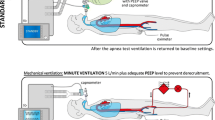Abstract
Background
Pneumothorax is an under-recognized complication of apnea testing performed as part of the neurological determination of death. It may result in hemodynamic instability or even cardiac arrest, compromising ability to declare brain death (BD) and viability of organs for transplantation. We report three cases of pneumothorax with apnea testing (PAT) and review the available literature of this phenomenon.
Methods
Series of three cases supplemented with a systematic review of literature (including discussion of apnea testing in major brain death guidelines).
Results
Two patients were diagnosed with PAT due to immediate hemodynamic compromise, while the third was diagnosed many hours after BD. An additional nine cases of PAT were found in the literature. Information regarding oxygen cannula diameter was available for nine patients (range 2.3–5.3 mm), and flow rate was available for ten patients (mean 11 L/min). Pneumothorax was treated to resolution in the majority of patients (n = 8), although only six completed apnea testing following diagnosis/treatment of pneumothorax and only three patients became organ donors afterward. Review of major BD guidelines showed that although use of low oxygen flow rate (usually ≤ 6 L/min) during apnea testing is suggested, the risk of PAT was explicitly mentioned in just one.
Conclusion
Development of PAT may adversely affect the process of BD determination and could limit the opportunity for organ donation. Each institution should have preventive measures in place.


Similar content being viewed by others
References
Wijdicks EFM, Varelas PN, Gronseth GS, Greer DM. Evidence-based guideline update: determining brain death in adults: report of the Quality Standards Subcommittee of the American Academy of Neurology. Neurology. 2010;74:1911–8.
Goudreau JL, Wijdicks EF, Emery SF. Complications during apnea testing in the determination of brain death: predisposing factors. Neurology. 2000;55:1045–8.
Datar S, Fugate J, Rabinstein A, Couillard P, Wijdicks EFM. Completing the apnea test: decline in complications. Neurocrit Care. 2014;21:392–6.
Bar-Joseph G, Bar-Lavie Y, Zonis Z. Tension pneumothorax during apnea testing for the determination of brain death. Anesthesiology. 1998;89:1250–1.
Burns JD, Russell JA. Tension pneumothorax complicating apnea testing during brain death evaluation. J Clin Neurosci. 2008;15:580–2.
Goranovic T, Milan Z, Kasi M, Martinac V. Barotrauma during apnea testing for the diagnosis of brainstem death. Minerva Anestesiol. 2015;81:818.
Hasan N, Landsberg D. Bilateral tension pneumothoraces during apnea testing. Chest. 2011;140:40A.
Vivien B, Haralambo MS, Riou B. Barotrama during apnea testing for the determination of brain death. Ann Fr Anesth Reanim. 2001;20:370–3.
Cros J, Pichon N, Dugard A, Vignon P, François B. Barotrauma by Venturi effect during apnea testing for the determination of brain death. Should it change the terms of application of this test? Ann Fr d’anesthèsie rèanim. 2009;28:900–2.
Saposnik G, Rizzo G, Deluca JL. Pneumothorax and pneumoperitoneum during the apnea test: how safe is this procedure? Arq Neuropsiquiatr. 2000;58:905–8.
Shemie SD, Baker AJ, Knoll G, Wall W, Rocker G, Howes D, et al. National recommendations for donation after cardiocirculatory death in Canada: donation after cardiocirculatory death in Canada. CMAJ. 2006;175:S1.
AMRC. A code of practice for the diagnosis and confirmation of death. PPG Des. Print Ltd. 2008;1–42. http://www.knowledge.scot.nhs.uk/media/CLT/ResourceUploads/1011665/DofD-final-2.pdf. Accessed 13 July 2016.
The ANZICS statement on death and organ donation [Internet]. [cited 2016 May 10]. ANZICS Statement on Death and Organ Donation.
Henry NR, Marshall SG. Apnea testing: the effects of insufflation catheter size and flow on pressure and volume in a test lung. Respir Care. 2014;59:406–10.
Disclosures
Dr. Rajat Dhar receives consulting fees from Mid-America Transplant, the local organ procurement organization.
Author information
Authors and Affiliations
Corresponding author
Rights and permissions
About this article
Cite this article
Gorton, L.E., Dhar, R., Woodworth, L. et al. Pneumothorax as a Complication of Apnea Testing for Brain Death. Neurocrit Care 25, 282–287 (2016). https://doi.org/10.1007/s12028-016-0299-x
Published:
Issue Date:
DOI: https://doi.org/10.1007/s12028-016-0299-x




